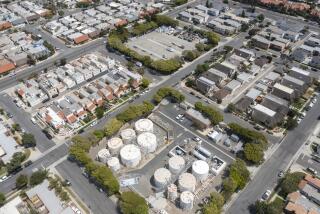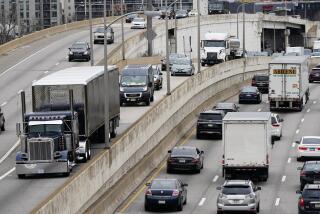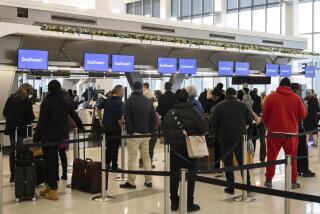Restrictions on Airspace Near Busy Airports Urged
CHARLOTTE, N.C. — U.S. Transportation Secretary Elizabeth Hanford Dole on Saturday announced a proposal to make the skies safer by restricting airspace around busy airports and requiring the installation of anti-collision systems in airplanes.
Dole said small planes lacking advanced communications equipment would be kept out of the Terminal Control Areas, or TCAs, at nine additional airports unless they had approval from air traffic controllers to enter the space.
Private planes are already restricted from flying in the TCAs of the 23 busiest U.S. airports, including Los Angeles International Airport, where the FAA tightened rules on unregulated airspace last week.
Not a Result of Crash
Dole said that besides the restrictions on private planes, the Transportation Department will require the installation of collision avoidance systems on all commercial aircraft, and will consider requiring all planes to have traffic alert equipment or transponders.
Speaking at a news conference in Charlotte, Dole said the proposals did not result from last Sunday’s crash of a Northwest Airlines jet in Detroit but “is something that’s been in the works.”
The newly restricted areas will be over Baltimore-Washington International and Dulles International airports in the Washington area; Orlando and Tampa, Fla.; Phoenix; Salt Lake City; Memphis, Tenn.; Charlotte, and Hobby Airport in Houston.
Concern about aerial crashes has heightened amid an increase this year in the number of near-collisions reported by pilots.
During the first six months of 1987, pilots reported 50% more near-collisions than during the corresponding period a year ago. Earlier this month, a private pilot passed close to President Reagan’s helicopter over the mountains near the President’s California ranch.
Collision Over Cerritos
An Aeromexico DC-9 collided with a small private plane over Cerritos, Calif., in August, 1986, and last January, a commuter plane collided with a private aircraft over Salt Lake City.
Rep. Bob Wise (D-W.Va.), a member of the House Government Operations subcommittee on transportation, said in an interview that Dole’s proposals are helpful but will not solve the problem of the nation’s overcrowded skies.
“We have 2,600 fewer air traffic controllers today than we had in 1981, but there has been a 26% increase in air traffic in that time,” Wise said. “We’re stretching people too thin.”
A TCA is a section of airspace surrounding an airport. The airspace is designed to provide safe routes for commercial jetliners and other more sophisticated aircraft in and out of the busiest airports.
Radar Required
A pilot must obtain permission from a controller to enter a TCA and the aircraft must have equipment--a so-called Mode-C radar transponder--that allows the controller to determine the plane’s altitude.
Owners and fliers of private planes are likely to lobby against the new zone restrictions, which some said could force small planes to make a large detour around the Washington area, where the restricted areas over airports would overlap.
Dole said the collision-avoidance system, TCAs II, is designed to alert pilots that another aircraft with an audio beacon is in its area and could eliminate 82% of near-collisions.
Representatives of the Air Line Pilots Assn. have expressed concern that the collision avoidance device might not give a pilot room to avoid a collision under certain approach or takeoff conditions.
More to Read
Inside the business of entertainment
The Wide Shot brings you news, analysis and insights on everything from streaming wars to production — and what it all means for the future.
You may occasionally receive promotional content from the Los Angeles Times.










